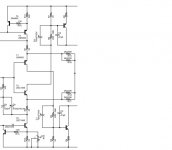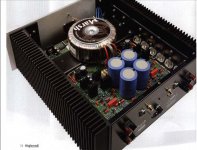So TO-3 cased output transistors can not be used for audio then?
All TO-3 type transistors have a casing made of steel. However some old 2N3055 had the TO-3 casing made of aluminum.
All TO-3 type transistors have a casing made of steel. However some old 2N3055 had the TO-3 casing made of aluminum.
As this is a build DIY place, this sort of detail of a detail comes up from time to time on any design; If you care about small amounts of distortion being additive, it is just cheap and easy to avoid by using copper leads... which are plentiful. If transistors did not need steel, KOVAR et al that might be nice but -other than copper- it is needed for more important and practical reasons. Of course.
In wire and in parts leads for our lowest distortion efforts, use copper. If you dont care about that, then dont worry but it is there and measurable. Myself, I care as my interest is in very low distortion circuits of all types and its measurement.... and all the various causes of the low level distortions.
BTW, I know nothing about BYBEE and arent likely to know as the cost is too high for small gain. But for low cost parts and wire etc, just use copper when ever possible.... If you care. IMO. After the designs are good, then better and best... one's can also look at details of details to improve the performance further. This takes the high-end design further into another level and most people dont go there.
It is all good. OK. Back to the basics of better to best CFA design. These minute details can be pursued another time/place. But, they do/will come up for others to dig deeper, if they choose to.
Thx-RNMarsh
In wire and in parts leads for our lowest distortion efforts, use copper. If you dont care about that, then dont worry but it is there and measurable. Myself, I care as my interest is in very low distortion circuits of all types and its measurement.... and all the various causes of the low level distortions.
BTW, I know nothing about BYBEE and arent likely to know as the cost is too high for small gain. But for low cost parts and wire etc, just use copper when ever possible.... If you care. IMO. After the designs are good, then better and best... one's can also look at details of details to improve the performance further. This takes the high-end design further into another level and most people dont go there.
It is all good. OK. Back to the basics of better to best CFA design. These minute details can be pursued another time/place. But, they do/will come up for others to dig deeper, if they choose to.
Thx-RNMarsh
Last edited:
funny how most HF coax has steel core...
for strength and cost. Core is not used much to propagate signal at HF/RF..... nothing to do with generation of low distortion levels.
-RNM
Last edited:
This (steel chassis) was not the topic.
Mr. Marsh stated that MIL components (with heavy copper plated iron core terminals) are to be avoided, since they add distortions. As long as this statement cannot be substantiated, it remains what it is: another piece of anecdotic in the delusional audiophile toolbox.
As SW said, he has measured it.... you can get much higher numbers with higher current flow -- such as found in Power Amps (spkr crossovers et al). Which is the reason I brought it up here. The original work i read decades ago suggested to me a rule that to be unmeasureable (into the noise floor) you need to keep wiring in PA at least 2.5cm from a steel chassis.
Personnally I dont care if it is audible or not. Thats a whole other thing. If it could be removed thru the whole process from recording microphone to playback speaker, would it matter - maybe. but, this is about electronics and related details to me.
Thx-RNMarsh
Last edited:
It strikes me spontaneously a new product on this topic:
A shield around the living room to shield the Earth's magnetic field 😀
That already exists, it is the Somebody Else's Problem field - Hitchhikers
Clipping (hard or soft) is a non issue IMO. Just dont do it. Scale and match system componenets so it doesnt happen. It should be an accident if it clips and should not blow up if it did get accidently clipped.
How good can you make an amp sound while clipping isnt a worthy subject.... worthy if it involves circuit/speaker protection etal.
THx-RNMarsh
Hi Richard,
Unfortunately, clipping happens. Unless, of course, you have VERY big amplifiers with decently efficient speakers. At RMAF 1996 Peter Smith and I demonstrated the issue using a peak/average digital power meter I designed. We played Rickie Lee Jones "Getto of My Mind" from her Flying Cowboys album in a typical hotel room at realistic (but not overly loud) levels using quality loudspeakers with 84 dB efficiency. The Denon 250 wpc amp we used clipped, while average power out of the amp per channel was less than 2W. You have to see it to believe it.
Clipping happens more often than you think. Its too bad virtually no audiophile amplifiers have honest clipping indicators.
Bottom line: don't dismiss clipping issues.
Of course, the plethora of crappy, compressed program material lulls us into complacency about clipping.
Cheers,
Bob
After several time do sim, I understand about "current on demand" in CFA input. Simple CFA like VSSA can have high dissipation on input transistor T1 and T2 in certain condition (like high voltage power supply, etc). I propose using R for limiting VCE on T1 and T2 and parallel with C for avoid response peaking. We can use low voltage, low noise, high hFE on T1 and T2. Ostripper suggest me to use high power TO-92 device.
More suggestion welcome. I am still learn 🙂 and want make amp simple as possible, with low distortion and high slew rate 😀.
More suggestion welcome. I am still learn 🙂 and want make amp simple as possible, with low distortion and high slew rate 😀.
Attachments
Yes to all this. I've spent a loo.ong time looking at various clip indicators while listening to music.Unfortunately, clipping happens. Unless, of course, you have VERY big amplifiers with decently efficient speakers. At RMAF 1996 Peter Smith and I demonstrated the issue using a peak/average digital power meter I designed. We played Rickie Lee Jones "Getto of My Mind" from her Flying Cowboys album in a typical hotel room at realistic (but not overly loud) levels using quality loudspeakers with 84 dB efficiency. The Denon 250 wpc amp we used clipped, while average power out of the amp per channel was less than 2W. You have to see it to believe it.
Clipping happens more often than you think. Its too bad virtually no audiophile amplifiers have honest clipping indicators.
Bottom line: don't dismiss clipping issues.
Of course, the plethora of crappy, compressed program material lulls us into complacency about clipping.
I'd like a 200W/channel 8R amp .. not cos I won't clip it .. but cos DBLT bla bla show I don't usually mind the amount of clipping it does on the speakers & music I like (which includes some of my own recordings and designs).
If I was doing DB listening tests on speakers, I'd like a 1000W/channel amp and again I (& my test subjects) would clip it now & then.
And all this is predicated on exemplary overload & recovery behaviour of the amps.
Alas, if an amp has clipping indicators, the customer feels he needs them to flash to show he's getting his money's worth. You think I'm joking don't you! 😱
_________
Bob, I'm glad you said "crappy, compressed program material" rather than "music". 🙂
Clipping happens - deal with it.
Hi Bob,
It cant be dismissed if you dont know there is a problem and dont deal with it so you dont have that problem anymore. But we here ought to know better.... I would think. To do a CFA amp at 50W was nuts to me. You might only need a 5W to be loud... but not clean and not producing harmonics from clipping. And, of course we test for thd withOut clipping. yet people say amps sound different. Hmmm. I wanted 250W at least and I have 92dB effecient woofers. I said recently, somewhere around here, that amps used to have clipping indicators on them. They were left off because of dealers--- they didnt like them showing clipping when they played them in demo's.
Its a good subject and maybe we can design an add-on clipping indicator so all can see what thier amps are doing most/some of the time. Eventually, by listening tests, it was decided by the Gods in power at the time to put in clipping delays/averagers and thus indicate more accurately what was being percieved. But still the dealers won out. Couldnt play thier low power amps without clipping and below clipping wasnt loud enough. And, higher power would cost too much and sales would fall. So here we have a hidden distortion generator which the public isnt told about -- just the thd/Im spec. 😡
How good are DBL when amps are clipping and thresholds of audibility in clipping are exceeded... what can be drawn from such test results and comments about the sound of an amp or speaker for what is preferred et al? Is it inconceivable that people would want to limit the HF response when amps are clipping and producing HF harmonics that are annoying? It puts doubt in the findings.
Following that issue came dividing up the power spectrum with electronic cross-overs -- as the bass is a likely cause of much of the clipping, it's distortion from clipping could be contained to a more narrow range of freqs and the other amps for mid/high could be lower power and still not clip.
--- take it from there --- expand --
Thx-RNMarsh
Hi Richard,
Unfortunately, clipping happens. Unless, of course, you have VERY big amplifiers with decently efficient speakers.
Clipping happens more often than you think. Its too bad virtually no audiophile amplifiers have honest clipping indicators.
Bottom line: don't dismiss clipping issues.
Of course, the plethora of crappy, compressed program material lulls us into complacency about clipping.
Cheers,
Bob
Hi Bob,
It cant be dismissed if you dont know there is a problem and dont deal with it so you dont have that problem anymore. But we here ought to know better.... I would think. To do a CFA amp at 50W was nuts to me. You might only need a 5W to be loud... but not clean and not producing harmonics from clipping. And, of course we test for thd withOut clipping. yet people say amps sound different. Hmmm. I wanted 250W at least and I have 92dB effecient woofers. I said recently, somewhere around here, that amps used to have clipping indicators on them. They were left off because of dealers--- they didnt like them showing clipping when they played them in demo's.
Its a good subject and maybe we can design an add-on clipping indicator so all can see what thier amps are doing most/some of the time. Eventually, by listening tests, it was decided by the Gods in power at the time to put in clipping delays/averagers and thus indicate more accurately what was being percieved. But still the dealers won out. Couldnt play thier low power amps without clipping and below clipping wasnt loud enough. And, higher power would cost too much and sales would fall. So here we have a hidden distortion generator which the public isnt told about -- just the thd/Im spec. 😡
How good are DBL when amps are clipping and thresholds of audibility in clipping are exceeded... what can be drawn from such test results and comments about the sound of an amp or speaker for what is preferred et al? Is it inconceivable that people would want to limit the HF response when amps are clipping and producing HF harmonics that are annoying? It puts doubt in the findings.
Following that issue came dividing up the power spectrum with electronic cross-overs -- as the bass is a likely cause of much of the clipping, it's distortion from clipping could be contained to a more narrow range of freqs and the other amps for mid/high could be lower power and still not clip.
--- take it from there --- expand --
Thx-RNMarsh
Last edited:
After several time do sim, I understand about "current on demand" in CFA input.
More suggestion welcome. I am still learn 🙂 and want make amp simple as possible, with low distortion and high slew rate 😀.
😎🙂
Thx-RNMarsh
Even if this would reveal something in measurements (over the 2.726K cosmic background noise), last time I've checked the iron screw terminals belong to the load, not to the amplifier.
Waly,
You are just dodging the issue... current thru and in proxy with nonlinear materials produce harmonic distortion. Just natural facts, my man.
It's one of the advantages of making it to old age... wisdom thru tests and experience. it just takes time --
Tonight, just for Waly, I took the steel bottom cover off a Denon multiChannel amp -- I laid the tests leads on the that cover -- tapped the lead to the cover. The load was the 300 Ohms selected input Z on the A-P analyzer. And the voltage level set to only 1v rms at only one freq = 1Khz.
I dont know the alloy of the cover other than it is ferrous material (magnetic).
The added harmonic is shown for this metal type. I am playing with steel wire also and the like to get a feel for what harmonics are generated by different materials and thru direct current flow.
Anyway, this is only passing 3mA near the material at one freq. Not a worst case situation - like several amps and multiTones etc that exist when playing music thru the amp. But I think you can imaging it gets a lot worse from here. No I wont be showing everything I learn from this exercise... just that it exists in copper wire leads and in proxy with metal made of ferrous material. Same happens when currrent goes through a ferrous wire. Trust me. 🙂
I am anticipating your next comment to come -
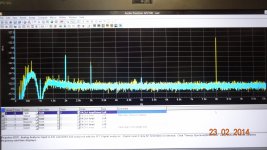
THx-RNMarsh
Last edited:
I practice what I preach. Only the bridge holding the transformer is steel.
of course.
THx-RNMarsh
of course.
THx-RNMarsh
Last edited:
Waly,
You are just dodging the issue... current thru and in proxy with nonlinear materials produce harmonic distortion. Just natural facts, my man.
It's one of the advantages of making it to old age... wisdom thru tests and experience. it just takes time --
Tonight, just for Waly, I took the steel bottom cover off a Denon multiChannel amp -- I laid the tests leads on the that cover -- tapped the lead to the cover. The load was the 300 Ohms selected input Z on the A-P analyzer. And the voltage level set to only 1v rms at only one freq = 1Khz.
I dont know the alloy of the cover other than it is ferrous material (magnetic).
The added harmonic is shown for this metal type. I am playing with steel wire also and the like to get a feel for what harmonics are generated by different materials and thru direct current flow.
Anyway, this is only passing 3mA near the material at one freq. Not a worst case situation - like several amps and multiTones etc that exist when playing music thru the amp. But I think you can imaging it gets a lot worse from here. No I wont be showing everything I learn from this exercise... just that it exists in copper wire leads and in proxy with metal made of ferrous material. Same happens when currrent goes through a ferrous wire. Trust me. 🙂
I am anticipating your next comment to come -
View attachment 401897
THx-RNMarsh
There seems to be a signature 8H with hard steel. Here is the same setup with just 3 mA of current --> 3 inch of steel wire (about #20 awg) and 2 turns of #18 awg thru a ferrite core (#43, I think).
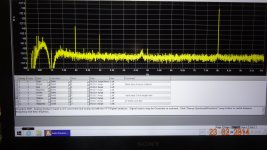
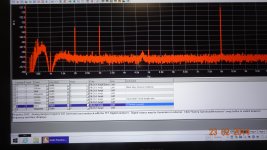
Done for now - need a clean >1A signal to compare;
THx-RNMarsh
Last edited:
I practice what I preach. Only the bridge holding the transformer is steel.
THx-RNMarsh
Looking at your factory tour, seems that you are using TO-3s with steel casing.
The emitter is connected to the PCB using the TO-3 case as a conductor.
Marsh Sound Design ~ Experience the Sound with MSD Products !!!
Nice factory by the way.
Looking at your factory tour, seems that you are using TO-3s with steel casing.
The emitter is connected to the PCB using the TO-3 case as a conductor.
Marsh Sound Design ~ Experience the Sound with MSD Products !!!
Nice factory by the way.
yes, old design. Cant change everything to copper or aluminum.... just what is in my control. BTW-- Other newer models use plastic power devices... and same for MOSfets amps (for oem). Even less steel involved.
A billionaire Chinese-Thai man owned the land and built the whole factory (3 buildings) for me so he/we could do oem. Then our economy went over the cliff. I only saw him twice. He is in the cement/construction business I am told. I have no idea what motivated him.... guess he just liked me. I visit them once a year and keep in touch. That's why I just bought a new condo there... plus its very interesting region of the world to me.
-RM
Last edited:
Clipping can never happen if you are willing to put a level control at the amp input which automatically lowers the input voltage to the amplifier so that it never can clip... saw McIntosh use this approach.
Thx-RNMarsh
Thx-RNMarsh
yes, old design. Cant change everything to copper or aluminum.... just what is in my control. BTW-- Other newer models use plastic power devices... and same for MOSfets amps (for oem). Even less steel involved.
A billionaire Chinese-Thai man owned the land and built the whole factory (3 buildings) for me so he/we could do oem. Then our economy went over the cliff. I only saw him twice. He is in the cement/construction business I am told. I have no idea what motivated him.... guess he just liked me. I visit them once a year and keep in touch. That's why I just bought a new condo there... plus its very interesting region of the world to me.
-RM
Some people say that power BJT or MOSFET sounds better in in TO-3 metal case then the same counterpart in plastic case(lateral power Hitachi MOSFET), or LME49710 sound better in TO-99 metal case then the same one in PDIP plastic package. How you explain that, almost all metal cases(some old exist in aluminum) are magnetic?
BR Damir
...
Unfortunately, clipping happens. Unless, of course, you have VERY big amplifiers with decently efficient speakers. At RMAF 1996 Peter Smith and I demonstrated the issue using a peak/average digital power meter I designed. We played Rickie Lee Jones "Getto of My Mind" from her Flying Cowboys album in a typical hotel room at realistic (but not overly loud) levels using quality loudspeakers with 84 dB efficiency. The Denon 250 wpc amp we used clipped, while average power out of the amp per channel was less than 2W. You have to see it to believe it.
Clipping happens more often than you think. ...
I still fail to see how this can happen with a digital source. 0 dBFs is a hard limit,
if we adjust a playback chain so that the full level from the DAC is just below the
clipping point of the amp how would any program material ever be above that ?
"loudspeakers with 84 dB efficiency" Well "efficiency" is almost an euphemism in
this case, such speakers usually distort at peaks anyway even if you have
more than the 250W you mentioned at your disposal.
... and maybe we can design an add-on clipping indicator so all can see what thier amps are doing most/some of the time. ...
Oh yes, this would be very useful to clarify things.
I was about to write the same thing. We can adjust the playback chain such as the only clipping which can ever occur is in the record and never in the reproducing system at home.I still fail to see how this can happen with a digital source. 0 dBFs is a hard limit,
if we adjust a playback chain so that the full level from the DAC is just below the
clipping point of the amp how would any program material ever be above that ?
Maybe we can introduce the concept of a "clipping margin" : the ratio of the peak voltage ever encountred at the amp output when listening to the maximal peak voltage that the amp can deliver.just below the clipping point
- Home
- Amplifiers
- Solid State
- CFA Topology Audio Amplifiers
